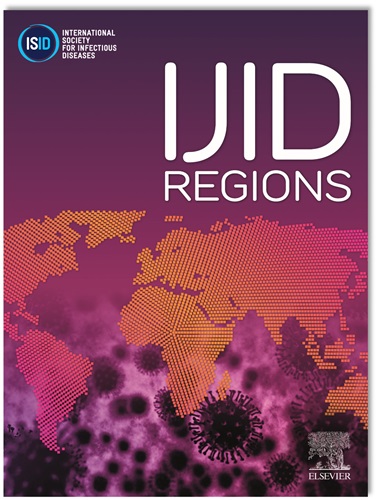为什么电子邮件会失败?确定关键预测因素以改善念珠菌血流感染的临床结果:一项回顾性多中心队列研究。
IF 4.3
2区 医学
Q1 INFECTIOUS DISEASES
引用次数: 0
摘要
背景:棘白菌素是治疗念珠菌血流感染(C-BSIs)的一线药物。治疗失败(TF)的发生率仍然很高,危险因素不明。目的:探讨棘白素TF对c - bsi的预测因素。方法:回顾性观察性多中心研究,纳入2020年6月1日至2023年6月30日在意大利四家医院接受棘白菌素治疗的所有C-BSI患者。主要结局:评估TF的预测因素,定义为:i)在治疗第5天转入ICU或器官功能障碍恶化;(二)持续C-BSI;iii)因任何原因停用棘白菌素;iv)在治疗期间出现念珠菌感染的新部位。次要结局:90天全因死亡率。采用Cox回归和治疗效应,以及治疗加权逆概率(IPTW)来调整队列治疗分配偏倚。结果:总共有218名患者入组。中位(第一季度-第三季度)年龄为72岁(56-78岁),55%为男性。在33%和63%的病例中,报告了脓毒性休克和非白色念珠菌菌株引起的c - bsi。重要的是,根据临床判断,68例(31%)患者接受了高剂量棘白菌素治疗(“HDE”:比标准剂量增加30-50%)。82例(38%)发生TF;90天全因死亡率为30%,tnf组(p30)或血清白蛋白浓度≤2.5 gr/dL显著高于tnf组(p < 0.05)。结论:多种临床和微生物因素可影响棘白菌素TF。有趣的是,对于有棘白菌素TF风险的患者,HDE可能具有保护作用。本文章由计算机程序翻译,如有差异,请以英文原文为准。
Why do echinocandins fail? Identifying key predictors to improve clinical outcomes of candida bloodstream infections: a retrospective multicenter cohort study
Background
Echinocandins represent first-line therapy for Candida Bloodstream Infections (C-BSIs). Incidence of treatment failure (TF) remains high with unclear risk factors. Aim: to evaluate predictors of echinocandin TF for C-BSIs.
Methods
Retrospective observational multicenter study, enrolling all patients with C-BSI treated with echinocandin from 01/06/2020 to 30/06/2023 in four Italian Hospitals.
Primary outcome
to evaluate predictors of TF defined as a composite of: i)transfer to ICU or any worsening in organ dysfunction at day 5 of therapy; ii)Persistent C-BSI; iii)Echinocandin discontinuation for any reason; iv)Onset of a new infection site by Candida spp. during treatment.
Secondary outcome
90-day all-cause mortality. Cox regression and treatment-effect were used, along with inverse-probability of treatment-weighting (IPTW) to adjust cohort treatment-assignment bias.
Results
Overall, 218 patients were enrolled. Median (q1-q3) age was 72 (56-78), 55% male. In 33% and 63% of cases, septic shock at presentation and C-BSIs by non-albicans strains were reported. Importantly, 68 (31%) patients received high dosage echinocandin (“HDE”: increase of 30-50% of standard dosage), according to clinical judgement. Eighty-two (38%) experienced TF; 90-day all-cause mortality was 30%, significantly higher in TF-group (P < 0.001). At multivariable Cox-regression analysis, obesity, septic shock, and increased MIC to echinocandins were predictors of TF; presence of removable intravascular devices and HDE resulted protective. After adjustment by inverse-probability of treatment-weighting, HDE still reduced TF risk in patients admitted to the ICU, with SOFA score<6, BMI>30, or with serum albumin concentration ≤2,5gr/dL.
Conclusion
Several clinical and microbiological factors could influence the echinocandin TF. Interestingly, in patients at risk for echinocandin TF, HDE may be protective.
求助全文
通过发布文献求助,成功后即可免费获取论文全文。
去求助
来源期刊
CiteScore
18.90
自引率
2.40%
发文量
1020
审稿时长
30 days
期刊介绍:
International Journal of Infectious Diseases (IJID)
Publisher: International Society for Infectious Diseases
Publication Frequency: Monthly
Type: Peer-reviewed, Open Access
Scope:
Publishes original clinical and laboratory-based research.
Reports clinical trials, reviews, and some case reports.
Focuses on epidemiology, clinical diagnosis, treatment, and control of infectious diseases.
Emphasizes diseases common in under-resourced countries.

 求助内容:
求助内容: 应助结果提醒方式:
应助结果提醒方式:


